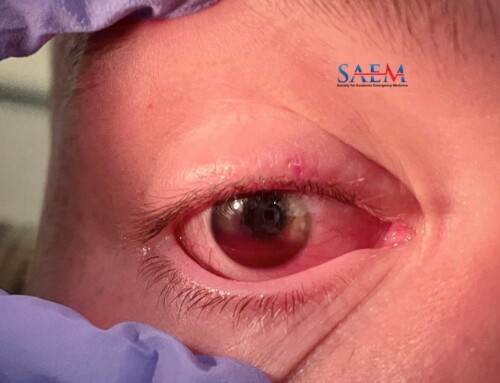 It’s 3 am in the middle of your busy night shift and you begin your evaluation of a 65 year-old woman with diabetes with several hours of unilateral flashes of light in her left eye. Her visual fields seem normal, but you are unable to see her fundus with your direct ophthalmoscope. Luckily, you remembered the teaching from your ultrasound rotation during residency.
It’s 3 am in the middle of your busy night shift and you begin your evaluation of a 65 year-old woman with diabetes with several hours of unilateral flashes of light in her left eye. Her visual fields seem normal, but you are unable to see her fundus with your direct ophthalmoscope. Luckily, you remembered the teaching from your ultrasound rotation during residency.
Ocular Ultrasound Technique
- Let the patient know your plan: placing ultrasound gel and a probe over her eye. To make the exam more comfortable for the patient (and reduce the chances of getting ultrasound gel into the eye), place a transparent adhesive dressing on the patient’s closed eye. A linear transducer (10-5 MHz) will offer a high level of resolution with adequate depth, as the eye is a superficial structure. Stabilize your hand on the patient’s nasal bridge or zygoma, and gently place the transducer on the closed eyelid (probe marker facing to the patient’s right).

- With a normal gain setting, adjust your depth to ensure that you can see the posterior segment of the eye and the optic nerve. Once basic structures are identified, reduce the gain until the vitreous is black (anechoic). Ask the patient to move her closed eye from left to right. This is called oculokinetic echography, and allows a clear examination of vitreous abnormalities that are not firmly attached to the retina.
- Retinal detachment (RD) will be visualized in normal and often low gain settings. A RD has the appearance of a thick cord that is attached to the back wall of the eye and moves with eye movement. If the RD is large, the flap will be attached firmly to the optic nerve sheath. For small RDs, the sonographer should carefully evaluate multiple axes of the eye (horizontal and vertical) to look for a tethered flap adherent to the back wall of the eye. In contrast, posterior vitreous detachments (PVD), are only loosely adherent and will move freely with kinetic echography.
Once you have interrogated the vitreous body at normal settings, slowly increase the gain. Often, high gain will allow abnormalities of the vitreous to be better visualized. Vitreous hemorrhages (VH) and posterior vitreous detachments (PVD) will be apparent as the gain is increased. In contrast to RD, a PVD takes on a “swaying seaweed” appearance. It is seen as a thin, linear structure, which is not tethered to the optic disc. As the patient moves her eye, the linear flap will float back and forth, cross the optic nerve and will not be tethered to the back wall.
VHs will be seen as diffuse mobile opacities on high gain, taking on a “snow globe” appearance. Commonly seen in diabetics or after a concurrent PVD, patients commonly present with floaters. Even though not an ophthalmologic emergency, the ED sonographer should be able to recognize VHs, and ensure the lack of underlying posterior segment pathology (PVD and/or RD).
Summary
For the novice sonographer, we recommend ophthalmologic involvement when a linear structure is noted in the posterior segment of the eye. A high level of sensitivity will reduce false negative examinations (missing a retinal detachment). Urgent evaluations are recommended for a retinal detachment, while a specialist can see vitreous abnormalities (detachment and hemorrhage) in a non-urgent manner. As always, using your clinical examination in a patient with visual disturbances in conjunction with point-of-care ultrasound examination will allow for the highest level of care.
Take home points
- Cover the closed eye with a transparent adhesive cover (always remove air from under the transparent dressing).
- Ask the patient to move the eye back and forth with normal gain. Look for a flap that is tethered to the back wall. Along with being attached to the posterior aspect of the eye, a retinal detachment is a thick flap that will be easily visualized on low gain.
- Increase the gain slowly while the patient is rapidly moving her eye. PVDs and VHs will not be tethered to the retina, and will float in the vitreous body.
Bibilography
- Sharma S, Ventura AACM, Waheed N. Vitreoretinal Disorders. Ultrasound Clinics. 2008;3(2):217–228. Journal site
- Shinar Z, Chan L, Orlinsky M. Use of Ocular Ultrasound for the Evaluation of Retinal Detachment. J Emerg Med. 2011;40(1):53–57. PMID 19625159
- Yoonessi R, Hussain A, Jang TB. Bedside Ocular Ultrasound for the Detection of Retinal Detachment in the Emergency Department. Acad Emerg Med. 2010;17(9):913–917. PMID 20836770
Authors
Dr. Christine Riguzzi
Ultrasound Fellow / Attending Physician
Alameda Health System Highland General Hospital
Dr. Oron Frenkel
Ultrasound Fellow / Attending Physician
Alameda Health System Highland General Hospital
Dr. Arun Nagdev
Director, Emergency Ultrasound
Alameda Health System Highland General Hospital
Assistant Clinical Professor
University of California, San Francisco




